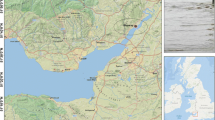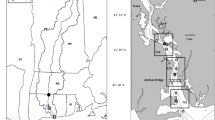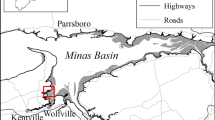Abstract
Grain size is the most basic of classification criteria for sediments. The size distribution of a given sediment records the physical transport processes involved in its formation. By using precise grain size analysis and the model of Kranck et al. (1996a,b), it is possible to break down a sediment into the three major components from which it was formed: material deposited as flocs, material deposited as single grains from suspension, and material carried under higher energy conditions. With this method, both the amount of material deposited in a flocculated state and the maximum size, or floc limit, of the particles composing the floc can be determined. Changes in floc limit indicate changes in the aggregation dynamics of the system. As most trace metals and many other contaminants associate closely with the fine particle fraction of sediments, it is important to determine both the areal distribution and reworking history of the floc settled portion of a sediment. This paper discusses the application of the method to coastal inlets in Atlantic Canada and examines the relationship between proportion of floc-settled material and trace metal concentrations. Disaggregated inorganic grain size distributions are also used to illustrate changes in the aggregation dynamics in areas of intense aquaculture.
Similar content being viewed by others
References
Gibbs, R.J., Matthews, M.D. and Link, D.A.: 1971, J. Sed. Petrol. 41, 7–18.
Hargrave, B.T.: 1994, Can. Tech. Rep. Fish. Aquat. Sci., 1949, 79–91.
Hargrave, B.T., Phillips, G.A., Doucette, L.I., White, M.J., Milligan, T.G., Wildish D.J. and Cranston, R.E.: 1996, Can. Tech. Rep. Fish. Aquat. Sci. 2062, v + 159p.
Hill, P. S. and Nowell, A. R. M.: 1995, J. Geophys. Res., 100(C11): 22, 749-22, 763.
Honeyman, B.D. and Santschi, P.H.: 1989, J. Mar. Res. 47, 951–992.
Jackson, G.A., 1995, Deep Sea Res. II. 42, 1, 159-184.
Kepkay, P.E., Niven, S.E.H. and Milligan, T.G.: 1993, Mar. Ecol. Prog. Ser. 100, 233–244.
Kranck, K., 1980, Can. J. Earth Sci. 17, 1517–1526.
Kranck, K., 1993, Arch. Hydrobiol./Suppl. 75, 299–309.
Kranck, K. and Milligan, T.: 1980, Mar. Ecol. Prog. Ser. 3, 19–24.
Kranck, K. and Milligan, T.: 1983, Mitteilungen aus dem Geologisch-Paleontologisch Institut der Universitat Hamburg, 52, Degens E.T. (ed).
Kranck, K. and Milligan, T.G.: 1985, Geomarine Letters, 5, 61–66.
Kranck, K. and Milligan, T.G.: 1989, Can. Tech. Rep. Hydrogr. Ocean Sci., 112: iv, 61 pp.
Kranck, K., Smith, P.C. and Milligan, T.G.: 1996a, Sedimentology, 43, 589–596.
Kranck, K., Smith, P.C. and Milligan, T.G.: 1996b, Sedimentology, 43, 589–596.
Loring, D.H.: 1988 Can. Bull. Fish. Aquat. Sci., 220, 99–122.
Loring, D.H. and Nota, D.J.G.: 1968, J. Fish. Res. Board Can., 182: 147 pp
Loring, D.H. and Rantala, R.T.T.: 1992, Earth Sci. Rev., 32, 235–283.
Loring, D.H., Rantala, R.T.T. and Milligan, T.G.: 1996, Can. Tech. Rep. Fish. Aquat. Sci. 2111: vii+268pp.
Milligan, T.G. and Kranck, K.: 1991, Theory, Methods and Applications of Particle Size Analysis Cambridge University Press, New York, 109–118.
Muhle, K.: 1993, Coagulation and Flocculation: theory and application, Lib. Congress Surfactant Sci. Ser., 47, 355–390.
Muller, F.L.L.: 1996, Mar. Chem., 52, 245–268
Muschenheim, D.K., Kepkay, P.E. and Kranck, K.: 1989, Neth. J. of Sea Res., 23(3), 283–292.
Niven, S.E.H., Kepkay, P.E. and Borale, A.: 1995, Deep Sea Res. II, 42, 1, 257-273.
Schell, T. M.: 1996, Proximal to distal trends of the floccculation limit of fine-grained turbidites. Dalhousie University MSc. thesis, 178pp.
Spicer, P.T. and Pratsinis, S.E.: 1996, Water Res., 50, 5, 1049-1056.
Rantala, R.T.T. and Loring, D.H.: 1989, Anal. Chem., 220, 263–267.
Tambo, N. and Hozumi, H.: 1979, Water Res., 13, 421–427.
Trites, R.W. and Petrie, L.: 1995, Can Tech. Rep. Hydrogr. Ocean Sci., 163: 53pp.
van Leussen, W.: 1988, Physical Processes in Estuaries, Springer Verlag, Berlin, New York, 404–426.
Zwolsman, J.J.G., van Eck, G.T.M. and Burger, G.: 1996, Estuaine, Coastal Shelf Sci., 43, 55–79.
Author information
Authors and Affiliations
Rights and permissions
About this article
Cite this article
Milligan, T., Loring, D. The Effect of Flocculation on the Size Distributions of Bottom Sediment in Coastal Inlets: Implications for Contaminant Transport. Water, Air, & Soil Pollution 99, 33–42 (1997). https://doi.org/10.1023/A:1018307710140
Issue Date:
DOI: https://doi.org/10.1023/A:1018307710140




